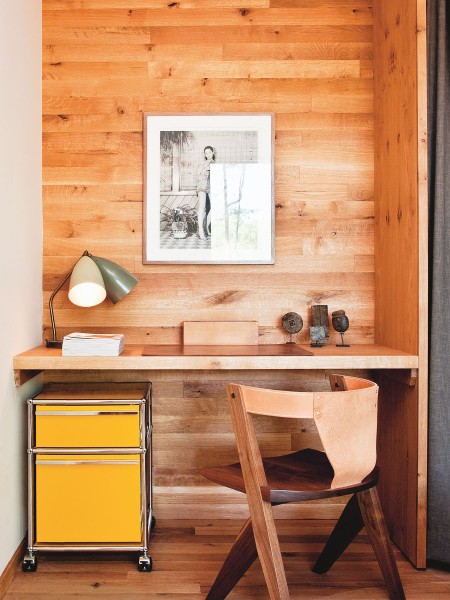Furnishing a small office is no easy task. If you work in your home office, the study must not only be functional, but also visually stimulating. A beautiful workplace is important for staying focused and motivated at work. But ideas are not always easy to find. Furnishing small rooms is a difficult undertaking and much harder than furnishing a large room. Mistakes in the choice of furniture can affect how you perceive the size of the room. The workstation must be a good size and offer enough storage space, but at the same time it must not waste too much space in a small room. In many offices, classic office furniture is primarily functional. When furnishing a home office, however, you can design according to your own taste. Instead of a bulky filing cabinet, perhaps you would prefer a beautiful, open shelf? In the following, we have compiled some ideas and tips on how you can furnish and design your small office.
1. order is half the battle
In small offices, it is especially important to keep things tidy and give everything its proper place. Extreme order is not always possible for everyone, but even a few tricks help to keep the home office neat and tidy. Conventional office furniture often offers enough space for folders, notes and the like, but is not homely enough for working at home. Even though tidiness is very important in the office, a pleasant atmosphere and a living room feeling is motivating. The main workstation is the desk and this should be kept particularly tidy. Avoid a tangle of cables on and under the desk for a clean look. This is ensured by cable strips or cable ties with which you can cleverly organise and bundle cables. Various table holders for screens, smartphones, tablets or headphones keep the tabletop free. This looks tidy and creates the necessary space on the desk. Clear places should be found for documents, paper, pens and other writing accessories and these items should be kept bundled there so that they do not lie around. For pens, pencil cases or pen holders are suitable, for documents and paper, trays. Other accessories and small items that are not used all the time are best kept in baskets or boxes away from the desk. If you need extra organisation, you can use a labelling device to label documents on the shelf or in the cupboard. This ensures that nothing gets mixed up and everything finds its way back to its place.
2. visually enlarge a small room
With many simple tips and tricks, rooms and workplaces can be made to appear larger than they really are. Small rooms need special attention when furnishing and the right choice should always be made carefully. When furnishing small rooms, the right wall colour is an important tool for visual enlargement. Light colours reflect the light and brighten up the room. Dark colours and striking patterns are counterproductive in small rooms and have a diminishing effect. They absorb light and thus darken the room. White is a good choice to make the room appear larger. If white is too boring, you can use other colours such as light blue, pink and light grey. But even these colours should be used sparingly. One, at most two walls can be accentuated well. If that is not enough colour, you can add colour in the form of table mats, seat cushions or other items. The colours should be coordinated and similar. Too many different colours are distracting and chaotic. Choosing the right curtains, blinds or pleated blinds is also important. Here, too, white or another light colour should be used if possible. Dark curtains and the like directly absorb the light from the window and should therefore be avoided. Discreet and light patterns can be introduced into the room in this way and help to breathe life into the room.
Lighting is important for small rooms. Ideally, large windows in your office provide plenty of daylight and a bright study. However, this is not always available and of course cannot be easily changed. But with a few tricks, daylight and artificial light can be used optimally to illuminate the study. To double the natural light, mirrors or glass applications, such as picture frames, with glass panes are suitable. These reflect the light, brightening up the room and giving the impression of a second window. Scattering smaller reflective surfaces around the room also creates a good reflection of the light in the room. If there is not enough natural light and it is simply too dark, lamps are the perfect alternative to sunlight. Artificial light is not always easy to introduce into rooms. Artificial light is just that - artificial. As such, it can be uncomfortable, too glaring and cool. This has a negative effect on our well-being and state of mind. If possible, one should refrain from using strong, glaring light in one's own study. The most important lamp in the workplace is without question the desk lamp. It should illuminate the desk well and be bright enough without dazzling. To save additional space, lamps that can be mounted on the wall, on a shelf above the desk or with an arm directly on the desk are suitable. For good lighting in the room, a large ceiling lamp is a good choice. If you then find that there are still dark corners in the room, you can fall back on floor lamps here. Floor lamps distribute light evenly and can be cleverly used as accents.
3. plan vertically
In small rooms there is not much room for large, bulky furniture. It clutters up the room and takes up valuable space that can be better optimised. To make the best use of the room, all the space in the room must be utilised. To do this, it is worth using the entire surface of the walls. High cupboards, shelves or wall shelves are suitable for storing documents and other utensils. When decorating, also think about which items can best be stored in which pieces of furniture. Books can enliven the room and contribute to the decoration. Therefore, open shelves or wall shelves are good for storing books because they do not have to be hidden. For small items such as pens, cables, adapters, notes and other accessories, a closed cupboard is best. Smaller items are difficult to organise and store. If they are openly visible, the impression of disorder can quickly arise. Baskets, boxes or small slides are good ways of organising small items. This is a good way to hide and store small items without them lying around and creating clutter. "Vertical planning" can be applied not only to the furniture in the room, but also to the storage of documents or utensils on the desk or on the shelf. Shelves that can be stacked are suitable for the desk. This way, only a small area is taken up on the desk and there is more space to work. Pens can be stored upright in a pen holder.
4 Reduce to the bare essentials
Six pens, two hole punches, printer, scanner, fax machine etc. Do you really need all that? When space is at a premium, it's important to consider which items you really need in your office - and which you don't. Nobody needs several pens of the same colour, or several devices that can do the same thing. Reduce unnecessary clutter that has no use and create space and order. Combination devices that combine several functions make sense. This means that instead of a printer, scanner and fax machine, you only have one device. Other technical devices can also be reduced, if possible. If you do not need specific hardware, you can switch from a large PC tower to a mini PC or laptop with a docking station. These are much easier to store, take up less space in the study and can even be used for mobile working. When designing your study, you should also leave out unnecessary furniture and knick-knacks. Unless you have client contact in your study, you don't need armchairs, sofas or coffee tables as office furniture. Keep your private items out of your study and don't make it your second living room. Even if you are your home, a study is not a private space and should not be treated as such. A tiny room needs to be kept organised and tidy. In your home office, try to clearly separate work and private space.
5. use the space properly
To make the most of the space in a small room, it is important to choose the right furniture. In a study, you need a lot of storage space to accommodate everything you need. However, the furniture should not appear too bulky. A desk with many drawers on both sides is very practical, but it looks overpowering in a small office. To keep the room visually "open", a desk that is open on all sides is suitable. A slim drawer directly under the tabletop can house the essentials, to which you have quick access. If you need a little more space, you can place a mobile pedestal under or next to the desk. Large office cabinets are practical, but they quickly clutter up the room and block the light. If you absolutely need a cupboard, you should go for rather narrow models and place them in different places in the room instead of next to each other. Open shelves that allow light to shine through are more suitable. Every space counts, so the corners of a room should also be used well. You can do this with corner desks or corner shelves. If you find that you have too much to fit into your office, get a little creative. Get inspired and get your ideas flowing! Does the full length of the desk have to be against the wall? You could also place it with the short side against the wall and thus use the walls differently. Combination furniture is also a good alternative. A table that can be folded out or pulled out saves valuable space that can be used differently.




